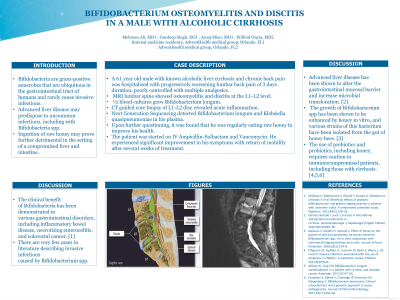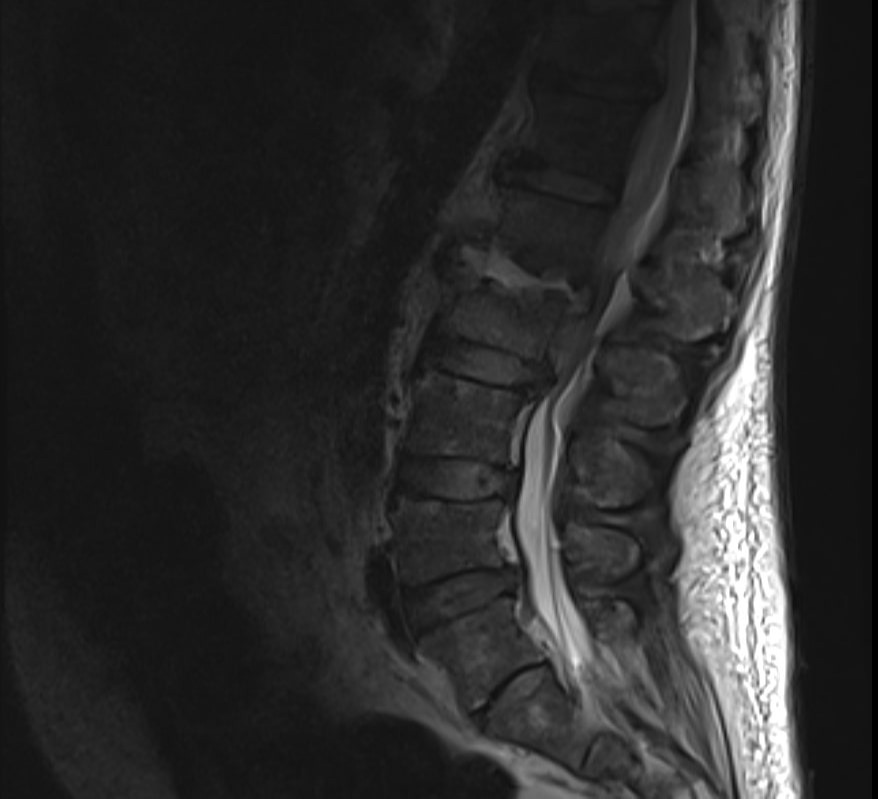Monday Poster Session
Category: Liver
P2592 - Bifidobacterium Osteomyelitis and Discitis in a Male with Alcoholic Cirrhosis
Monday, October 23, 2023
10:30 AM - 4:15 PM PT
Location: Exhibit Hall

Has Audio
- GS
Gurdeep Singh, DO
AdventHealth
Orlando, FL
Presenting Author(s)
Arooj Mian, MD, Gurdeep Singh, DO, Mehreen Ali, MD, Wilfred Onyia, MD
AdventHealth, Orlando, FL
Introduction: Bifidobacteria are gram-positive anaerobes that are ubiquitous in the gastrointestinal tract of humans and rarely cause invasive infections. Advanced liver disease may predispose to uncommon infections, including with Bifidobacteria spp. Ingestion of raw honey may prove further detrimental in the setting of a compromised liver and intestine.
Case Description/Methods: A 61-year-old male with known alcoholic liver cirrhosis and chronic back pain was hospitalized with progressively worsening lumbar back pain. He underwent magnetic resonance imaging of the lumbar spine with intravenous contrast that showed osteomyelitis and discitis at the L1-L2 level with small epidural and paraspinal abscesses. One out of two blood cultures grew Bifidobacterium longum. Next Generation Sequencing detected 1,283 DNA micromolecules per milliliter (MPM) of Bifidobacterium longum and 229 MPM Klebsiella quasipneumoniae (reference range < 10 MPM) in his plasma. The patient subsequently underwent a CT-guided biopsy of L1/L2 that revealed acute inflammatory changes but was otherwise unremarkable.
Upon further questioning, it was found that he was regularly eating raw honey to improve his health. The patient was treated with intravenous Ampicillin-Sulbactam and Vancomycin. He experienced significant improvement in his symptoms with return of mobility after several weeks of treatment.
Discussion: The clinical benefit of Bifidobacteria has been demonstrated in various gastrointestinal disorders, including inflammatory bowel disease, necrotizing enterocolitis, and colorectal cancer. There are very few cases in literature describing invasive infections caused by Bifidobacterium spp. The growth of Bifidobacterium spp. has been shown to be enhanced by honey in vitro, and various strains of this bacterium have been isolated from the gut of honeybees. Advanced liver disease has been shown to alter the gastrointestinal mucosal barrier and increase microbial translocation. The use of prebiotics and probiotics, including honey, requires caution in patients with cirrhosis.

Disclosures:
Arooj Mian, MD, Gurdeep Singh, DO, Mehreen Ali, MD, Wilfred Onyia, MD. P2592 - Bifidobacterium Osteomyelitis and Discitis in a Male with Alcoholic Cirrhosis, ACG 2023 Annual Scientific Meeting Abstracts. Vancouver, BC, Canada: American College of Gastroenterology.
AdventHealth, Orlando, FL
Introduction: Bifidobacteria are gram-positive anaerobes that are ubiquitous in the gastrointestinal tract of humans and rarely cause invasive infections. Advanced liver disease may predispose to uncommon infections, including with Bifidobacteria spp. Ingestion of raw honey may prove further detrimental in the setting of a compromised liver and intestine.
Case Description/Methods: A 61-year-old male with known alcoholic liver cirrhosis and chronic back pain was hospitalized with progressively worsening lumbar back pain. He underwent magnetic resonance imaging of the lumbar spine with intravenous contrast that showed osteomyelitis and discitis at the L1-L2 level with small epidural and paraspinal abscesses. One out of two blood cultures grew Bifidobacterium longum. Next Generation Sequencing detected 1,283 DNA micromolecules per milliliter (MPM) of Bifidobacterium longum and 229 MPM Klebsiella quasipneumoniae (reference range < 10 MPM) in his plasma. The patient subsequently underwent a CT-guided biopsy of L1/L2 that revealed acute inflammatory changes but was otherwise unremarkable.
Upon further questioning, it was found that he was regularly eating raw honey to improve his health. The patient was treated with intravenous Ampicillin-Sulbactam and Vancomycin. He experienced significant improvement in his symptoms with return of mobility after several weeks of treatment.
Discussion: The clinical benefit of Bifidobacteria has been demonstrated in various gastrointestinal disorders, including inflammatory bowel disease, necrotizing enterocolitis, and colorectal cancer. There are very few cases in literature describing invasive infections caused by Bifidobacterium spp. The growth of Bifidobacterium spp. has been shown to be enhanced by honey in vitro, and various strains of this bacterium have been isolated from the gut of honeybees. Advanced liver disease has been shown to alter the gastrointestinal mucosal barrier and increase microbial translocation. The use of prebiotics and probiotics, including honey, requires caution in patients with cirrhosis.

Figure: MRI of the lumbar spine with IV contrast that demonstrates osteomyelitis/discitis of L1-L2 with a small epidural abscess measuring 0.6 x 1.2 x 1.1 cm.
Disclosures:
Arooj Mian indicated no relevant financial relationships.
Gurdeep Singh indicated no relevant financial relationships.
Mehreen Ali indicated no relevant financial relationships.
Wilfred Onyia indicated no relevant financial relationships.
Arooj Mian, MD, Gurdeep Singh, DO, Mehreen Ali, MD, Wilfred Onyia, MD. P2592 - Bifidobacterium Osteomyelitis and Discitis in a Male with Alcoholic Cirrhosis, ACG 2023 Annual Scientific Meeting Abstracts. Vancouver, BC, Canada: American College of Gastroenterology.
